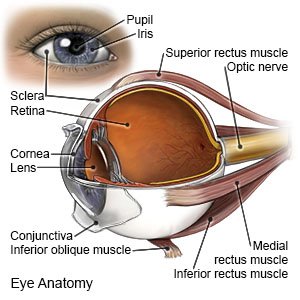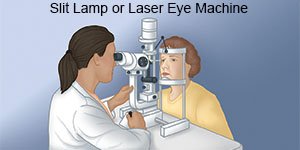Retinal Focal Laser
Medically reviewed by Drugs.com. Last updated on Apr 6, 2025.
What do I need to know about retinal focal laser treatment?
Focal laser is a procedure used to treat leaking blood vessels and edema (fluid buildup) in the retina. The laser creates heat that seals the vessels and vaporizes fluid in the area. Tissues in the retina also become thinner. The area of leaking vessels is smaller, creating less fluid buildup. Focal laser treatment will not give you back lost vision, but it can keep vision loss from getting worse. Diabetic macular edema is the most common condition focal laser is used to treat.
 |
How do I prepare for the procedure?
- Your healthcare provider will tell you how to prepare. Arrange to have someone drive you home after the procedure. You may need to have 1 eye treated at a time. Treatment may be a few weeks apart. You may also need to have more than one treatment on each eye. Make sure you arrange to have someone drive you home after each treatment session.
- Bring dark sunglasses to your focal laser appointments. Drops are used to dilate (widen) your pupils before treatment. Your pupils will absorb more harmful sunlight than usual while they are dilated. You will need to wear the dark sunglasses during your ride home.
- Tell your provider about all medicines you currently take. He or she will tell you if you need to stop any medicine for the procedure, and when to stop. He or she will tell you which medicines to take or not take on the day of the procedure.
Drugs used to treat this and similar conditions
Eylea
Eylea is used to treat several retinal disorders, such as neovascular (wet) age-related macular ...
Tresiba
Tresiba (insulin degludec) is used to treat diabetes mellitus. Includes Tresiba side effects ...
Ozempic
Learn about Ozempic (semaglutide) for type 2 diabetes treatment, weight management, cardiovascular ...
Humalog
Humalog (insulin lispro) is used to treat type 1 (insulin-dependent) diabetes in adults. Includes ...
Ozurdex
Ozurdex is an implant injected into the eye to treat swelling that may occur when there is a ...
Lantus
Lantus is a long acting form of insulin used to treat type 1 or type 2 diabetes. Learn about side ...
Novolog
NovoLog is a fast-acting insulin used to treat diabetes to control blood sugar levels in adults and ...
Lucentis
Lucentis is used to treat the wet form of age-related macular degeneration. Learn about side ...
What will happen during the procedure?
- You may be given local anesthesia as eyedrops or shots to help prevent discomfort. You may still feel a mild ache during the procedure, but you should not feel pain. A contact lens will be placed on your cornea. The lens will keep your eye still and help the laser focus.
- The machine used for the procedure is similar to the machine used during a regular eye exam. You will sit with your chin on the chinrest and your forehead against the headrest. You may be asked to look at a target with the eye that is not being treated. This helps you keep your treated eye where your provider wants it during treatment.
- The laser may be directed at certain blood vessels in the retina. It may be given in a grid pattern to target more vessels. You will see flashes of bright light during the procedure. Tell your provider if you feel severe pain while the laser is being used. He or she may need to make changes to your procedure.
- Anti-vascular endothelial growth factor (anti-VEGF) treatment may be given to reduce swelling and improve vision. Medicine is injected into the vitreous of the eye. The vitreous is the gel-like material that fills the inside of the eye.
 |
What should I expect after the procedure?
- You should be able to return to most activities right away.
- You may feel a mild ache in your eye or see flashes of light for a day or two.
- Your vision may be blurry for up to a week.
- You may have a headache for a few hours.
- It will take at least 3 months before healthcare providers know if the treatment worked.
What are the risks of focal laser treatment?
Cells in the retina near the treatment area may be damaged. Scars created to seal leaks may be close together. This can damage the part of the retina that gives the clearest vision. Abnormal blood vessels may grow under part of the retina, affecting vision. You may need anti-VEGF injections to treat vision loss from the blood vessels.
Care Agreement
You have the right to help plan your care. Learn about your health condition and how it may be treated. Discuss treatment options with your healthcare providers to decide what care you want to receive. You always have the right to refuse treatment. The above information is an educational aid only. It is not intended as medical advice for individual conditions or treatments. Talk to your doctor, nurse or pharmacist before following any medical regimen to see if it is safe and effective for you.© Copyright Merative 2025 Information is for End User's use only and may not be sold, redistributed or otherwise used for commercial purposes.
Further information
Always consult your healthcare provider to ensure the information displayed on this page applies to your personal circumstances.
